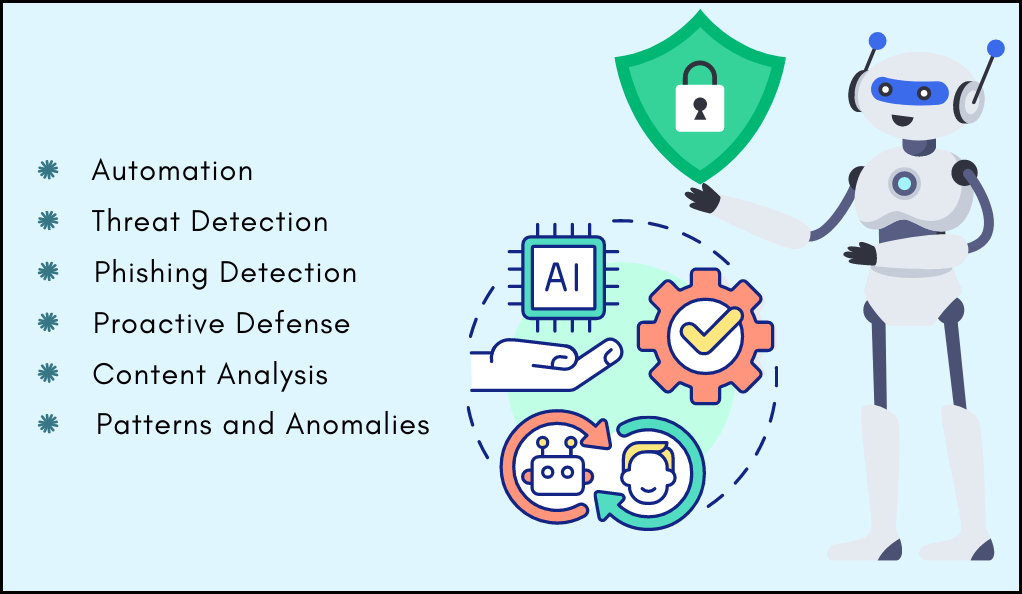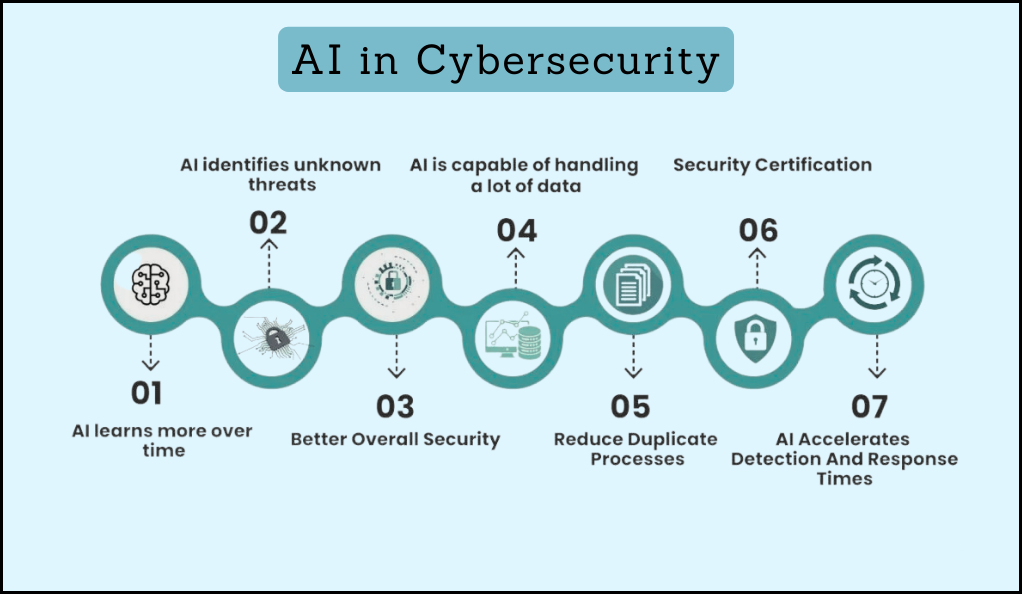Introduction
Artificial Intelligence (AI) has emerged as a transformative force across a multitude of industries, ushering in a new era of innovation and efficiency. The security sector, in particular, has witnessed a significant paradigm shift due to AI’s capabilities. The modern digital landscape is riddled with intricate cyber threats, and the sheer volume of data that organizations handle daily can be overwhelming. In this context, AI stands out as a beacon, providing advanced tools and methodologies to bolster security frameworks.
The integration of AI into security protocols is not just about automation but also about enhancing the precision and responsiveness of threat detection and mitigation strategies. As we delve deeper into the intricacies of AI-driven security, it becomes evident that the benefits are manifold. From real-time threat analysis to predictive modeling based on historical data, AI equips security professionals with a robust arsenal to combat cyber adversaries. However, as with any technological advancement, there are challenges to consider, ensuring that the adoption of AI in security is both strategic and informed.
The Role of AI in Security

In the realm of security, Artificial Intelligence (AI) is primarily centered on the automation of threat detection, response, and prevention. One of the pivotal roles AI undertakes is threat detection, where its sophisticated algorithms sift through vast data volumes at remarkable speeds, pinpointing patterns and anomalies that could signify potential security breaches.
Furthermore, AI delves into the archives of past security incidents, employing predictive analysis to forecast potential future threats, thereby enabling organizations to fortify their defenses proactively. On the email front, AI showcases its prowess by swiftly spotting phishing attempts, meticulously scrutinizing the content, sender’s credentials, and accompanying metadata. Additionally, the domain of physical security has been significantly bolstered by AI, with innovations like facial recognition and fingerprint analysis leading the charge in enhancing security protocols.
Benefits of AI in Security
- Speed: AI can analyze large datasets faster than any human, ensuring rapid threat detection.
- Accuracy: Reduced false positives and false negatives due to continuous learning capabilities.
- Adaptability: AI models can evolve with the changing threat landscape, ensuring up-to-date security measures.
- Cost-Efficiency: Automating security tasks can lead to reduced operational costs over time.
Potential Risks and Challenges
While AI offers numerous benefits, it’s essential to be aware of potential risks:
- Over-reliance: Sole dependence on AI can lead to missed threats if the system isn’t trained on a particular type of attack.
- Manipulation: Adversaries can attempt to “trick” AI systems using techniques like adversarial attacks.
- Privacy Concerns: The use of AI in surveillance and data analysis can raise privacy issues.
Comparison: Traditional Security vs. AI-Driven Security
| Feature | Traditional Security | AI-Driven Security |
|---|---|---|
| Speed | Slower due to manual processes | Rapid data analysis and response |
| Accuracy | Prone to human error | High accuracy with continuous learning |
| Adaptability | Requires manual updates | Evolves with changing threats |
| Cost | Higher operational costs | Initial setup cost but reduced operational costs over time |
Understanding AI and Machine Learning (ML)

Artificial Intelligence (AI) and Machine Learning (ML) are two of the most transformative technologies of the 21st century, often used interchangeably but distinct in their nature and applications.
Differences between AI and ML
At its core, AI is a broader concept that refers to machines or software being able to perform tasks that typically require human intelligence. These tasks can range from understanding natural language to recognizing patterns and making decisions. AI encompasses a variety of techniques and methods, of which ML is a subset.
Machine Learning, on the other hand, is a specific approach within AI. ML involves training machines to improve their performance on a task by feeding them data. Instead of being explicitly programmed to perform a task, ML algorithms use statistical techniques to learn patterns from data, allowing them to make predictions or decisions without being explicitly programmed for that specific output.
How AI and ML mimic human problem-solving
Both AI and ML draw inspiration from human cognitive processes, aiming to replicate our ability to learn, reason, and adapt. Just as humans learn from experience, ML algorithms learn from data. Over time, as more data is processed, the algorithm refines its model to improve accuracy. Similarly, AI systems, in general, aim to mimic human reasoning by evaluating multiple solutions to a problem, understanding context, and making informed decisions. The ultimate goal of both AI and ML is to create systems that can tackle complex problems with the same efficiency and adaptability as a human, but often at a scale and speed that humans cannot match.
The Game-Changing Impact of AI in Cybersecurity
In the ever-evolving landscape of cybersecurity, Artificial Intelligence (AI) has emerged as a revolutionary force, reshaping the way organizations approach threat detection, response, and prevention. The integration of AI into cybersecurity protocols has not only enhanced the efficiency of these systems but has also introduced a level of sophistication previously unattainable. Let’s delve deeper into the transformative impact of AI in this domain.

Real-time Threat Identification and Neutralization
One of the most significant advantages of integrating AI into cybersecurity is its ability to identify and neutralize threats in real-time. Traditional security measures often rely on predefined rules and signatures, which can be ineffective against novel or sophisticated attacks. In contrast, AI-driven systems continuously learn from the data they process, enabling them to recognize new patterns and anomalies that might indicate a security threat.
For instance, consider a Distributed Denial of Service (DDoS) attack, where a network is flooded with traffic to render it unavailable. AI can analyze network traffic patterns in real-time, detect unusual spikes or patterns, and instantly take corrective measures, such as rerouting traffic or blocking malicious IP addresses. This immediate response can mean the difference between a minor disruption and a major security breach.
Proactive Detection of Threats and Breaches
Beyond real-time responses, AI’s true potential lies in its proactive capabilities. By analyzing vast datasets, AI can identify vulnerabilities in a system before they are exploited. This predictive analysis, based on historical data and current system behaviors, allows organizations to fortify their defenses against potential threats.
For example, consider an organization’s internal network. Over time, AI can learn the typical behavior patterns of users and devices. If an employee’s account suddenly starts accessing sensitive data or performing administrative actions outside their usual scope, AI can flag this as suspicious, even if traditional security measures don’t recognize it as a breach.
Traditional vs. AI-Driven Cybersecurity
| Feature | Traditional Cybersecurity | AI-Driven Cybersecurity |
|---|---|---|
| Response Time | Often reactive, with delays | Real-time |
| Threat Detection | Based on predefined rules and signatures | Continuous learning from data patterns |
| Scope of Protection | Limited to known threats | Adaptable to new, evolving threats |
| Predictive Capabilities | Limited | High, based on vast data analysis |
The Dark Side: Hackers Using AI
As the digital age progresses, the tools and techniques employed in the realm of cybersecurity and cyber threats are in a constant state of evolution. While the integration of Artificial Intelligence (AI) into cybersecurity has been hailed as a game-changer, it’s essential to recognize that this powerful technology is a double-edged sword. Just as organizations harness AI to bolster their defenses, malicious actors are leveraging it to craft more sophisticated and potent cyber attacks.

The Alarming Rise of AI-powered Cyber Attacks
The adoption of AI by cybercriminals has led to a new breed of threats that are more adaptive, stealthy, and destructive. Traditional cyber attacks often relied on predefined patterns or signatures, making them detectable by conventional security measures. However, AI-powered attacks can learn and adapt, making them harder to identify and neutralize.
For instance, consider phishing campaigns. In the past, phishing emails were often generic and could be spotted by their poor grammar or suspicious links. With AI, hackers can now craft personalized phishing emails by analyzing vast amounts of data from social media and other sources. These emails can mimic legitimate communication so closely that even the most vigilant users might be deceived.
Moreover, AI can automate the process of finding vulnerabilities in software or systems. Instead of manually probing a system for weaknesses, AI-driven tools can scan and identify potential entry points at a much faster rate, increasing the chances of a successful breach.
The Importance of Staying Ahead in the AI Arms Race
In this escalating battle of AI-driven tactics, it’s imperative for organizations and security professionals to stay one step ahead. The AI arms race in cybersecurity is not just about defense but also about anticipating potential offensive strategies employed by hackers.
Proactive measures, such as investing in AI-driven threat detection systems that evolve with the threat landscape, are crucial. Regular training and awareness programs can help employees recognize and respond to AI-powered phishing attempts. Additionally, organizations should collaborate and share intelligence about new AI-driven threats, ensuring that the broader community is informed and prepared.
Benefits of Integrating AI into Cybersecurity Strategies
In the dynamic world of cybersecurity, where threats constantly evolve and the stakes are perpetually high, the integration of Artificial Intelligence (AI) stands out as a beacon of hope. AI’s capabilities extend far beyond automation, offering a range of benefits that can significantly enhance an organization’s security posture. Let’s delve into the multifaceted advantages of weaving AI into cybersecurity strategies.
- AI’s Ability to Learn and Evolve
One of the most compelling attributes of AI is its capacity for continuous learning. Unlike traditional systems that operate based on static rules, AI-driven security tools can learn from every interaction, refining their algorithms over time. This means that as new threats emerge, the AI system adapts, ensuring that defenses remain robust and up-to-date without the need for constant manual intervention.
- Superiority in Identifying Unknown Cyber Threats:
Traditional cybersecurity measures often rely on signature-based detection, which means they can only identify threats that have been previously encountered and cataloged. AI transcends this limitation. By analyzing patterns and behaviors, AI can detect anomalies that might indicate a novel threat, even if it’s the first time such a threat has been encountered. This proactive approach ensures that organizations are not just reacting to known threats but are also prepared for the unknown.
- Handling Vast Amounts of Data and Identifying Hidden Threats:
The digital age has ushered in an era of big data. Every day, organizations generate and interact with vast amounts of data, within which malicious activities can easily hide. Manually sifting through this data to identify threats is not just time-consuming but also impractical. AI, with its advanced data processing capabilities, can swiftly analyze these vast datasets, identifying hidden threats that might otherwise go unnoticed. This ensures a more comprehensive security coverage, safeguarding all facets of an organization’s digital infrastructure.
- Accelerated Vulnerability Management
Vulnerabilities in software or systems can serve as entry points for cyber attackers. Identifying and patching these vulnerabilities promptly is crucial. AI accelerates this process. Instead of waiting for periodic vulnerability scans, AI-driven tools can continuously monitor systems, identifying and even patching vulnerabilities in real-time. This proactive approach reduces the window of opportunity for attackers, enhancing overall security.
Traditional vs. AI-Driven Cybersecurity Benefits
| Feature | Traditional Cybersecurity | AI-Driven Cybersecurity |
|---|---|---|
| Learning Capabilities | Static, rule-based | Dynamic, evolving with new data |
| Threat Detection | Signature-based, known threats | Behavior-based, including unknown threats |
| Data Handling | Limited, manual analysis | Comprehensive, automated analysis |
| Vulnerability Management | Periodic scans | Continuous monitoring and real-time patching |
The Future of AI-Driven Cybersecurity
The integration of Artificial Intelligence (AI) into cybersecurity is not just a contemporary trend but a glimpse into the future of digital defense. As cyber threats grow in complexity and volume, the reliance on AI to counter these challenges is set to increase. This article delves into the predictions, statistics, and market growth associated with AI-driven cybersecurity, painting a comprehensive picture of what the future holds.
Predictions and Statistics on AI Adoption in Cybersecurity
- Rapid Adoption Rates: As per industry analysts, by the end of the decade, over 85% of cybersecurity tools will be AI-integrated, up from the current 40%. This surge is a testament to the growing trust and reliance on AI’s capabilities.
- Shift from Reactive to Proactive Defense: AI will enable organizations to transition from a reactive stance, where threats are addressed post-breach, to a proactive one, predicting and neutralizing threats even before they manifest.
- Enhanced Insider Threat Detection: With the ability to analyze user behaviors and patterns, AI will play a pivotal role in detecting insider threats, which are often harder to spot using traditional methods.
- Automated Incident Response: The future will see AI not just detecting threats but also autonomously responding to them, reducing the time between threat detection and neutralization.
Revenue Projections and Market Growth
The economic implications of AI’s integration into cybersecurity are profound. The market is poised for exponential growth, driven by increasing cyber threats and the evident benefits of AI-driven defense mechanisms.
- Current Valuation: As of now, the AI-driven cybersecurity market stands at approximately $8.8 billion.
- Projected Growth: By 2027, this figure is expected to skyrocket to over $38.2 billion, marking a Compound Annual Growth Rate (CAGR) of 23.1%.
- Investment in R&D: Tech giants and startups alike are pouring resources into research and development, aiming to create more advanced and efficient AI-driven cybersecurity tools. It’s estimated that R&D investments in this sector will exceed $15 billion by 2025.
AI-Driven Cybersecurity Market Overview
| Metric | Current (2023) | Projection (2027) |
|---|---|---|
| Market Valuation | $8.8 billion | $38.2 billion |
| AI Integration in Tools | 40% | 85% |
| R&D Investment | $5.2 billion | >$15 billion |
Ethical Considerations in AI-Driven Security
While the integration of Artificial Intelligence (AI) into cybersecurity offers a plethora of benefits, it’s essential to approach this fusion with a balanced perspective. The marriage of AI and cybersecurity, though promising, is not devoid of challenges and concerns. From ethical dilemmas to potential pitfalls, this article provides a comprehensive overview of the hurdles that lie ahead in the realm of AI-driven cybersecurity.
Ethical Considerations in AI-Driven Security

- Bias and Discrimination: AI models are trained on vast datasets, and if these datasets contain biases, the AI system can perpetuate or even amplify these biases. In the context of cybersecurity, this could lead to unfair targeting or profiling of certain groups or individuals.
- Privacy Concerns: AI-driven security tools often require access to vast amounts of personal and organizational data. The collection, storage, and analysis of this data raise significant privacy concerns, especially if misused or mishandled.
- Autonomous Decision Making: As AI systems become more autonomous, there’s a risk of them making decisions without human oversight. This could lead to unwarranted actions, such as blocking legitimate users or overlooking genuine threats.
- Transparency and Accountability: AI algorithms, especially deep learning models, are often termed as “black boxes” due to their complexity. This lack of transparency can make it challenging to ascertain why a particular decision was made, leading to potential accountability issues.
Potential Pitfalls and Areas of Improvement
- Over-reliance on AI: Sole dependence on AI for security can be risky. If the AI system is compromised or encounters a scenario it hasn’t been trained on, it could lead to vulnerabilities.
- Adversarial Attacks: Cybercriminals are developing techniques to “fool” AI systems, known as adversarial attacks. These involve subtly altering input data to deceive the AI model, making it see something that isn’t there or overlook something that is.
- Scalability Concerns: As cyber threats evolve, AI models need to be continuously trained on new data. Ensuring that these models scale efficiently and remain up-to-date is a significant challenge.
- Integration with Legacy Systems: Many organizations still rely on older, legacy systems. Integrating advanced AI-driven security tools with these systems can be complex and may introduce new vulnerabilities.
Conclusion
In the rapidly evolving digital landscape, the fusion of Artificial Intelligence (AI) with cybersecurity stands as a testament to technological advancement and innovation. While AI’s capabilities promise a future of enhanced digital defense, robust threat detection, and proactive security measures, it’s imperative to approach this integration with a discerning eye. The myriad of benefits offered by AI-driven cybersecurity is counterbalanced by ethical dilemmas and potential pitfalls that demand attention and resolution.
As we navigate the complexities of this AI-driven cybersecurity era, a holistic approach is paramount. This involves not only harnessing the unparalleled capabilities of AI but also addressing the inherent challenges with diligence and foresight. By striking this balance, organizations can ensure a secure, transparent, and ethical digital future, safeguarding both their assets and the broader digital ecosystem.








